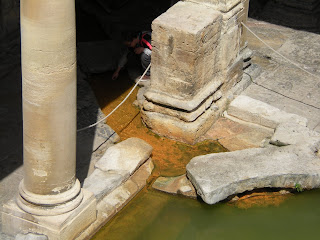 They are known as some of the finest thermal spas of the ancient world (Bath). The Sacred Spring, Roman Temple, Roman bath house and Georgian Pump Room are the rooms which make up the Roman Baths at Bath (Bath). Upon entering the area which surrounds the main bath, I was amazed at the beauty of the bathing facility. I also tried to imagine what the bath-scene was like in the
They are known as some of the finest thermal spas of the ancient world (Bath). The Sacred Spring, Roman Temple, Roman bath house and Georgian Pump Room are the rooms which make up the Roman Baths at Bath (Bath). Upon entering the area which surrounds the main bath, I was amazed at the beauty of the bathing facility. I also tried to imagine what the bath-scene was like in the  days of the Roman occupation, as well as the time of the 18th century when many city dwellers vacationed and planned to ‘take the waters’ with the intention to cure whatever ailed them.
days of the Roman occupation, as well as the time of the 18th century when many city dwellers vacationed and planned to ‘take the waters’ with the intention to cure whatever ailed them.The Romans founded and settled in many British cities, including Bath, England. The Roman Baths, also known as Aquae Sulis, were built between the 1st and 4th centuries around a natural hot spring (Portrait, 284). The sacred spring portion of the bath complex is currently enclosed by a reservoir named the King’s Bath (Portrait, 284). Water from the spring runs into the main bath at a constant temperature of 115 degrees Fahrenheit (Halliday, 17). Bath was a small town when the Romans arrived, but it was known as one of the finest architectural centers around because of the great temple and Bath house (Halliday, 17).
 These baths originated in the Roman times, but the natural hot spring which feeds the baths was considered sacred by the Celtics, who inhabited the area long before the Romans (web). According to the tale King Bladud was cast out from his Kingdom upon contracting leprosy in 860 BC. The king was healed once he “imitated his swine and rolled in the hot mud at Bath” (Leapman, 260). The Celtics believed the area was a sacred site to the water goddess Sulis, and it was believed that the spring possessed natural, curative powers (“The Roman”).
These baths originated in the Roman times, but the natural hot spring which feeds the baths was considered sacred by the Celtics, who inhabited the area long before the Romans (web). According to the tale King Bladud was cast out from his Kingdom upon contracting leprosy in 860 BC. The king was healed once he “imitated his swine and rolled in the hot mud at Bath” (Leapman, 260). The Celtics believed the area was a sacred site to the water goddess Sulis, and it was believed that the spring possessed natural, curative powers (“The Roman”). In AD 70 the Romans consolidated the area by building a circular, lead-lined reservoir (“The Roman”). They also built a temple to the goddess Sulis Minerva who was a
 combination of Sulis’ attributes as well as the Roman goddess Minerva’s attributes (Leapman, 260). The dedication of the baths to the goddesses was evidently very important as I saw a Roman relic of the head of the goddess Minerva in the Roman Bath museum.
combination of Sulis’ attributes as well as the Roman goddess Minerva’s attributes (Leapman, 260). The dedication of the baths to the goddesses was evidently very important as I saw a Roman relic of the head of the goddess Minerva in the Roman Bath museum. There was also a governmental district established at the baths, as well as a temple and altar – forming a sanctuary. After the initial construction of the baths, a vaulted chamber was added over the reservoir, the baths were extended, and the timber roofs were replaced with stones and tiles (“The Roman”). By the third century, the Roman Baths looked considerably different than they did when they were first constructed, as improvements and remodels occurred frequently (“The Roman”). Over the years, however, due to the lack of maintenance the drainage system failed and the baths were filled with black mud for several centuries (“The Roman”).
In later Saxon times, a nunnery, monastery and later on, an abbey were constructed on land surrounding the baths (“The Roman”). People were often encouraged to take the waters at the Roman Baths for medicinal purposes, but when Queen Anne of Denmark visited Bath in 1615, she established Bath as a fashionable destination to visit (“The Roman”). Visits to Bath were very common in the 18th century, and several building projects came about to extend the bathing facilities - transforming the bath complex and the whole town of Bath (“The Roman”). In 1880 the original Roman Bath complex was unearthed, and the Great Bath, Circular Bath, as well as the medieval King's Bath are on view to the public today (“The Roman”). The museum at the Roman Baths is a converted Methodist Chapel (Leapman, 261). The rows of pillars, statues, and concert room were late 19th century additions (“The Roman”).
Works Cited
Bath and North East Somerset Council. The Roman Baths. Bath and North East Somerset Council. 17 Jun 2008
Halliday, F.E. An Illustrated Cultural History of England. London: Thames and Hudson, 1967.
Leapman, Michael. Great Britain. New York City: DK Publishing Inc., 1995.
Leapman, Michael. Portrait of Britain. New York City: DK Publishing Inc., 1999.
"The Roman Baths, Bath." The Heritage Trail. 2007. The Heritage Trail: Britain's Premiere Independent Heritage Website. 17 Jun 2008


No comments:
Post a Comment